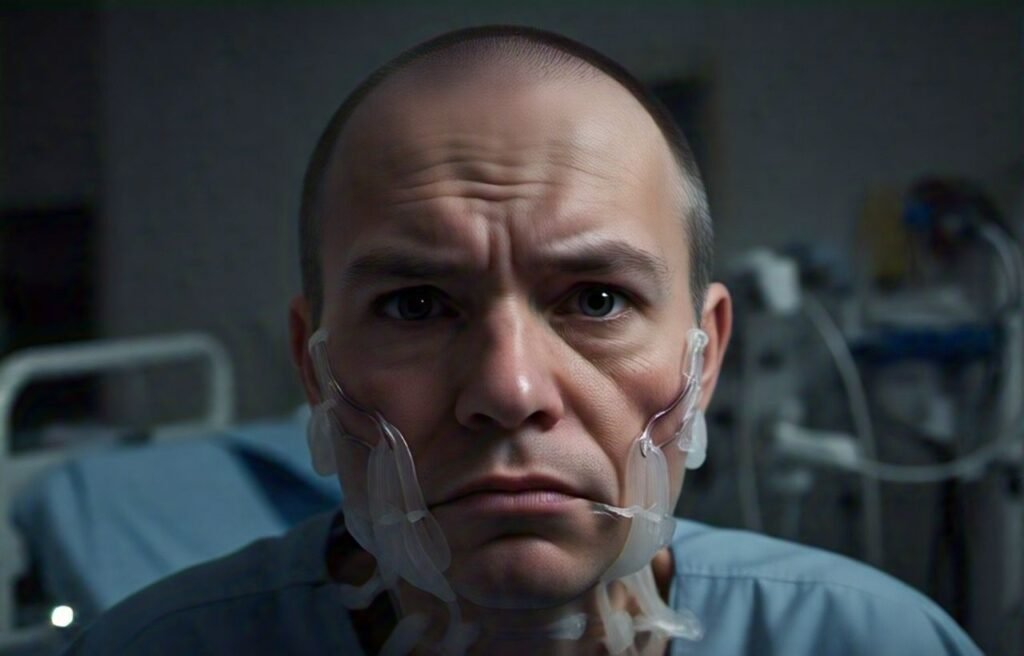This article discusses the lung cancer symptoms in men should be aware of. Lung Cancer is a significant health concern, particularly among men. With its often subtle onset, recognizing the symptoms early can be crucial for effective treatment. In this article, we’ll explore the various lung cancer symptoms in men, how they can manifest, and what steps to take if you or someone you know is experiencing these signs.
Table of Contents
What is Lung Cancer?
Before diving into the lung cancer symptoms in men, it’s important to understand what lung cancer is. Lung cancer occurs when cells in the lungs grow uncontrollably, forming tumors. There are two main types: non-small cell lung cancer (NSCLC) and small cell lung cancer (SCLC). NSCLC is the most common, accounting for about 85% of cases, while SCLC is more aggressive and less common.

The Importance of Early Detection of Lung Cancer Symptoms in Men
Detecting lung cancer early can significantly improve treatment outcomes. Unfortunately, lung cancer symptoms in men may not appear until the disease is advanced. This article aims to provide valuable insights that can help men recognize potential warning signs.
Common Symptoms of Lung Cancer Symptoms in Men
1. Persistent Cough
One of the most common lung cancer symptoms in men is a persistent cough that does not go away. Unlike a regular cough that may result from a cold or allergies, a cough associated with lung cancer often worsens over time.
Example:
Picture a man who has been experiencing a persistent cough for several weeks, initially thinking that it is simply a result of seasonal allergies. He assumes that the change in weather and the presence of pollen are to blame for his discomfort. However, if this cough continues to linger and even starts to worsen over time, it may be an indication that he should consider seeking advice from a healthcare professional. Ignoring the lung cancer symptoms in men could lead to more serious health issues, so it is important for him to take this situation seriously and consult with a doctor to ensure that he receives the appropriate care and diagnosis.

2. Shortness of Breath
Men who are diagnosed with lung cancer often find themselves experiencing shortness of breath, particularly when engaging in physical activities or exertion. This particular lung cancer symptoms in men can manifest itself even in those individuals who have never had any previous problems related to breathing or respiratory health. As lung cancer progresses, the discomfort and difficulty in breathing may become more pronounced, highlighting a significant change in their overall respiratory function.
Data Insight:
The American Lung Association indicates that approximately 70% of individuals diagnosed with lung cancer will encounter shortness of breath at various stages throughout their illness. This symptom can manifest at different times and may vary in intensity, affecting the patients’ overall comfort and ability to engage in daily activities as their condition progresses.

3. Chest Pain
Chest pain can present itself in various ways, often described as either a sharp sensation or a dull ache, and it can be experienced in multiple regions, including the chest area, shoulders, or even the back. This discomfort may become more intense or pronounced when engaging in actions such as deep breathing, coughing, or laughing, all of which can trigger or worsen the sensation. Individuals experiencing this type of pain should be mindful that certain movements or activities may amplify their discomfort, potentially leading to increased awareness of the pain’s presence.
Real-World Example:
Imagine a man who often finds himself dealing with unsettling sensations of discomfort in his chest following various physical activities or exertion. If this uncomfortable feeling is something he has not felt before and it persists over time, it may very well indicate the presence of a more serious underlying health issue that needs to be addressed.

4. Coughing Up Blood
Coughing up blood, medically referred to as hemoptysis, is a serious and concerning lung cancer symptoms in men that warrants immediate attention and should never be overlooked. It is essential to understand that even the presence of small amounts of blood can signal a significant underlying health problem that may require prompt medical evaluation. Ignoring this symptom could lead to missing a potentially serious condition, so it is crucial to seek medical advice if you experience this unsettling occurrence.
5. Unexplained Weight Loss
Unexpected and unexplained weight loss can serve as a significant warning sign for lung cancer and various other serious health issues. It is important to recognize that men may experience unintentional weight loss as a result of the body’s heightened energy expenditure that occurs while battling the presence of cancer. This increased metabolic demand can lead to a situation where the body begins to consume its own energy reserves, resulting in weight loss despite no changes in diet or exercise habits.

Insight:
Research indicates that a significant number of lung cancer patients, approximately 40%, experience notable weight loss at the time of diagnosis. This involuntary weight loss, often referred to as cachexia, can be a distressing lung cancer symptoms in men and may significantly impact a patient’s quality of life.
6. Fatigue
Chronic fatigue that persists despite adequate rest can be a significant lung cancer symptoms in men. Men may experience debilitating tiredness and weakness, interfering with their daily routines, work, and overall quality of life. This persistent fatigue, often accompanied by other symptoms like unexplained weight loss or persistent cough, should prompt immediate medical attention.
7. Frequent Respiratory Infections
Frequent respiratory infections, particularly in men, can be a lung cancer symptoms in men, such as lung cancer. If a man experiences repeated bouts of bronchitis or pneumonia, it’s crucial to seek medical attention to rule out more serious conditions and receive timely diagnosis and treatment.
8. Hoarseness
Hoarseness or changes in voice quality, such as a persistent cough or difficulty speaking, can be early warning signs of lung cancer. These vocal changes may seem subtle at first but should not be ignored. If you experience any persistent changes in your voice, it’s crucial to consult with a healthcare professional for a thorough evaluation.
9. Swelling in the Face or Neck
Unexplained swelling in the face or neck can be a serious symptom of advanced lung cancer. This swelling, often accompanied by other lung cancer symptoms in men like shortness of breath or chest pain, may indicate that the tumor is compressing vital blood vessels. If you experience sudden or persistent swelling in these areas, it’s crucial to seek immediate medical attention.

Risk Factors for Lung Cancer in Men
Understanding the risk factors can help men assess their likelihood of developing lung cancer. Here are some key factors:
- Smoking, The Leading Cause of Lung Cancer: Smoking is widely recognized as the primary risk factor for the development of lung cancer, accounting for an estimated 85% of all lung cancer cases. This alarming statistic highlights the significant impact that smoking has on overall lung health and cancer risk. In addition to active smoking, exposure to secondhand smoke also plays a critical role in increasing the likelihood of developing lung cancer, even among individuals who do not smoke themselves. Non-smokers who are regularly around smokers face a heightened risk due to the harmful substances present in the smoke, making it essential to consider the dangers of secondhand smoke.
- Beyond Smoking, Other Factors Contributing to Lung Cancer: Moreover, certain occupational hazards contribute significantly to lung cancer risk. Jobs that involve exposure to harmful substances such as asbestos, radon, or other known carcinogens can elevate an individual’s risk of developing the disease over time. These hazardous working conditions serve as a reminder of the importance of protective measures and regulations to safeguard workers in at-risk industries. Additionally, a family history of lung cancer can further influence an individual’s susceptibility to the disease. Those with relatives who have been diagnosed with lung cancer may find themselves at an increased risk, indicating a potential genetic or environmental component to the disease.
- The Impact of Age on Lung Cancer Risk, Especially in Older Men: Age is another critical factor associated with lung cancer risk, as the likelihood of developing the disease tends to rise significantly as individuals grow older. This risk is particularly pronounced in men aged 65 and older, who may be more susceptible to lung cancer due to a combination of age-related factors and potential lifetime exposure to risk factors such as smoking and environmental toxins. Overall, understanding these various risk factors is vital for raising awareness and encouraging preventive measures against lung cancer.
When to Seek Medical Attention
If you or someone you know is experiencing any of the lung cancer symptoms in men mentioned above, it’s crucial to seek medical attention promptly. Early diagnosis can significantly improve treatment options and outcomes.
Diagnostic Procedures
If lung cancer is suspected, healthcare professionals may recommend several diagnostic tests, including:
- Chest X-ray: This initial diagnostic procedure serves as a foundational assessment to detect any potential abnormalities within the lungs. It helps in revealing conditions such as infections, fluid buildup, or other issues that may require further investigation.
- CT Scan: This advanced imaging technique provides highly detailed cross-sectional images of the lungs, allowing healthcare professionals to obtain a comprehensive view. It is particularly useful for identifying tumors, assessing their size, shape, and location, which is crucial for planning further diagnostic or treatment strategies.
- Biopsy: This is a conclusive test in which a sample of lung tissue is carefully collected and subsequently examined under a microscope for the presence of cancer cells. This procedure is vital for accurately diagnosing lung cancer and determining the most effective course of treatment based on the specific type and characteristics of the cancer detected.

Treatment Options for Lung Cancer
If diagnosed with lung cancer, treatment options may include:
- Surgery: This procedure involves the careful removal of the tumor along with some of the surrounding healthy tissue to ensure that any microscopic cancer cells adjacent to the tumor are also eliminated. The goal is to achieve clean margins and enhance the chances of eradicating the cancer effectively.
- Radiation Therapy: This treatment option utilizes high-energy rays, such as X-rays or particles, aimed at precisely targeting and destroying cancer cells. By directing these powerful rays at the tumor, the therapy aims to damage the DNA of the cancer cells, ultimately leading to their death and reducing the size of the tumor.
- Chemotherapy: This approach employs a variety of potent drugs that are designed to kill cancer cells outright or inhibit their growth and division. Chemotherapy can affect not just the primary tumor, but also any cancer cells that may have spread throughout the body. It is often administered in cycles to allow patients time to recover from any side effects.
- Targeted Therapy: This type of treatment specifically focuses on the unique characteristics and genetic features of cancer cells. By understanding the molecular make-up of the cancer, targeted therapy can disrupt the processes that allow the cancer to grow and spread, providing a more personalized treatment strategy that minimizes damage to normal, healthy cells.
- Immunotherapy: This innovative treatment enhances the body’s own immune system, empowering it to more effectively recognize and combat cancer cells. By stimulating or restoring the immune response, immunotherapy aims to provide a sustainable way for the body to attack and control the growth of the cancer over time.
Conclusion
Recognizing the symptoms of lung cancer in men is crucial for early detection and treatment. If you or a loved one is experiencing persistent symptoms, it’s essential to consult a healthcare professional. Understanding the risk factors and being proactive about lung health can make a significant difference.
Frequently Asked Questions (FAQs)
1. What are the early signs of lung cancer in men?
The early signs of lung cancer can include a persistent cough, shortness of breath, and unexplained weight loss.
2. How is lung cancer diagnosed?
Lung cancer is diagnosed through a combination of imaging tests, such as X-rays and CT scans, and tissue biopsies.
3. What are the risk factors for lung cancer in men?
Key risk factors include smoking, exposure to secondhand smoke, occupational hazards, family history, and age.
4. Can lung cancer be treated successfully?
Yes, lung cancer can be treated successfully, especially when diagnosed early. Treatment options include surgery, chemotherapy, and radiation therapy.
5. What should I do if I experience symptoms of lung cancer?
If you experience symptoms such as a persistent cough or shortness of breath, it’s important to seek medical attention promptly for evaluation and potential diagnosis.
By staying informed about lung cancer symptoms and risk factors, men can take proactive steps to protect their health. Remember, early detection is key, so don’t hesitate to reach out to a healthcare professional if you have concerns.



